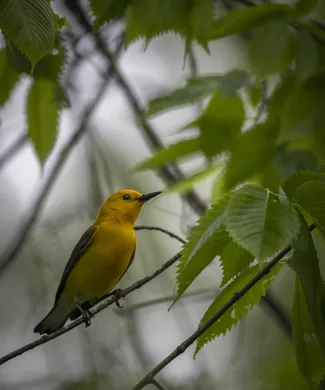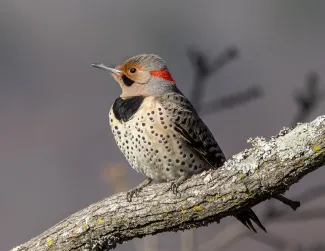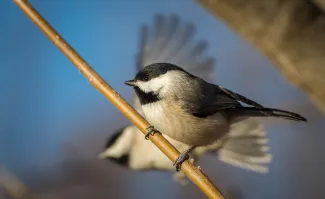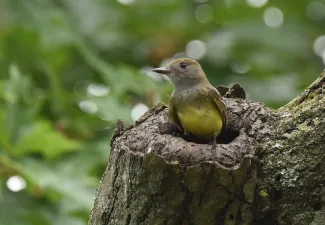Somewhere in northeastern Oklahoma, a small but vivid golden-yellow bird perches on a branch overhanging a stream. A spider struggles in its bill. The bird edges closer to the tree trunk and then vaults to the rim of a shadowed knothole a few inches above the branch. A second later, it disappears inside, where three fast-growing nestlings await their next meal.

Ten days and hundreds of such visits later, the three nearly grown prothonotary warbler chicks emerge from the knothole. Ordinary enough to be overlooked by the casual observer, this knothole is a critical habitat component essential for the existence of prothonotary warblers. It’s a place to conceal their nests.
The hollowed-out nesting location of the prothonotary warbler is unique among eastern U.S. warblers, but this colorful songbird is just one of Oklahoma’s 36 species of birds that regularly nests in weathered knotholes and other natural or newly excavated cavities.
Only a few species hide their eggs in the relative safety of cavities, but research shows cavity-nesters typically produce more successful nests than birds nesting in exposed cup nests. When compared to exposed nests, cavity nests are better protected from predators, sheltered from rain, and insulated against late spring freezes and Oklahoma’s midsummer heat. In addition to greater nest success, cavity nesting birds often have larger clutches and a longer nestling period. This means chicks raised in a cavity are older and potentially stronger when they fledge than chicks from an exposed nest.
But the added security provided by the cavity comes at a cost. On average, it takes longer to build a cavity nest than an open cup nest. Pileated woodpeckers can labor for 36 days before a new cavity is drilled to satisfaction, but the red-eyed vireo can assemble a suspended cup nest in the fork of a tree branch in about five days. Suitable cavities are also in short supply. After deciding a cavity is satisfactory, the new homeowner must fiercely defend the cavity from nearby pairs searching for a safe place to lay eggs. Birds aren’t the only animals hunting for a natural cavity or abandoned woodpecker nest. Flying squirrels, bats, white-footed mice and a number of other wildlife species often take up residence in a vacant cavity, or one where the original inhabitants were recently evicted.
In an effort to offset the limited number of nesting spaces available to cavity nesting birds, many outdoor enthusiasts install artificial nest boxes on their property, in city parks and even in wildlife management areas. While these boxes are often intended to attract eastern bluebirds, custom nest boxes may also entice these backyard birds to your property.
Three Cavity Nesting Birds
Northern Flicker

Flickers may seem drab at first, with black barring that subtly blends into a tan back. But a second glance reveals a boldly patterned beauty. The chest and belly is heavily spotted, and a dark crescent stain on the throat forms a bib or necklace. Flight reveals a white rump patch and hidden splash of yellow or red on the undersides of the wing and tail. Flickers in eastern Oklahoma tend to be “yellow-shafted,” while western Oklahoma birds are often “red-shafted.” Northern flickers are regularly seen on the ground, foraging for ants.
Nearly one-third of Oklahoma’s cavity nesting birds are woodpeckers, but only a few of those regularly use an artificial nest box. Instead, most woodpeckers prefer excavating their own cavity. To increase the odds of northern flickers or other woodpeckers using a nest box, we suggest packing the box with wood chips so the woodpecker can drill out its own cavity. Flickers also require larger artificial nest boxes than smaller songbirds. To fit a flicker family, the box should be 18 inches tall with a 7-by-7- inch floor. The entrance hole should be 2.5 inches in diameter. The large entrance hole will also permit non-native European starlings and house sparrows, so plan adequate control measures. Nest boxes intended for northern flickers should be mounted 8 to 20 feet above the ground.
Carolina Chickadee

A backyard-feeder favorite, the tiny Carolina chickadee rarely exceeds 5 inches in length. The black cap and throat are as recognizable as their persistent “chickadee-dee-dee” call. Aside from the white cheek patch, the rest of the body is gray. Though the short neck and rounded body shape give chickadees a stocky appearance, they are quite acrobatic. Chickadees often hang upside down as they glean insects from a tree branch. When visiting feeders, chickadees make several trips. They typically collect one seed per visit and fly to a nearby perch to extract the seed from its hull.
Chickadee pairs sometimes excavate their own cavity, which is a daunting and impressive task considering their tiny bills. But they will regularly use artificial nest boxes. For Carolina chickadees, build nest boxes at least 9 inches tall with a 4-by-4-inch floor. Drill a 1-1/8 inch entrance hole at least 7 inches above the floor. Moss is a popular nesting material for chickadees, and their nests can remain green throughout most of the nesting season.
Great Crested Flycatcher

A bird of the open woodlands, great crested flycatchers are more often heard than seen. Though many birders can identify this flycatcher by the loud “wheep” call alone, this bird must be seen to be fully appreciated. Great crested flycatchers are large, multicolored songbirds. The back is reddish brown. The face is grey, the belly is lemon-yellow, and the tail and wings are reddish-orange. Like many flycatchers, the great crested flycatcher hunts from a perch, sallying out to catch a nearby butterfly, bee or other flying insect. After the quick pursuit, the flycatcher returns to its perch high in the canopy.
To accommodate great crested flycatchers, nest boxes should be at least 12 inches tall with a 6-by-6-inch floor. The entrance hole should be 1 9/16 inches in diameter. Install nest boxes 6 to 20 feet high in a tree, or suspend the box from a sturdy branch.
Great crested flycatchers build a bulky nest of twigs, leaves and hair. Observers almost always find a snakeskin in the nest. Only one other Oklahoma flycatcher, the ash-throated flycatcher, nests in cavities.